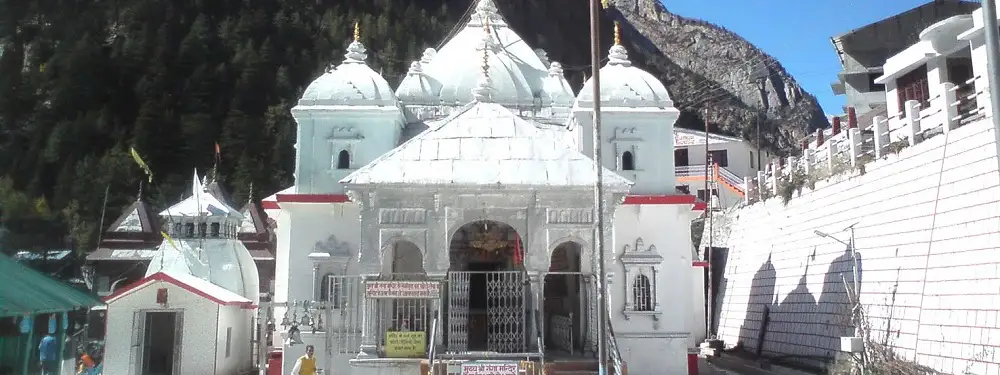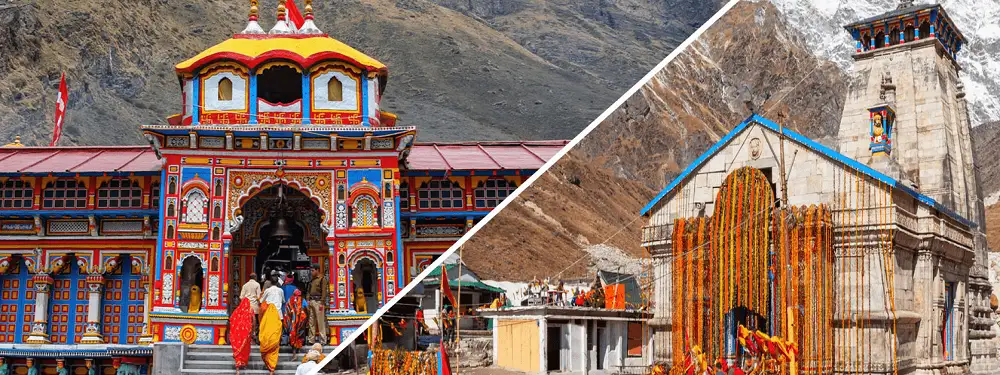


The Char Dham Yatra is a sacred journey nestled in the lap of the Himalayas. Comprising four holy sites—Yamunotri, Gangotri, Kedarnath, and Badrinath—this pilgrimage holds immense significance in Hinduism.
Every year, thousands of devotees embark on this divine circuit in Uttarakhand to seek spiritual purification and blessings.
You can start your journey from Haridwar and visit Yamunotri, Gangotri, Kedarnath, and finally Badrinath.
Yamunotri is the sacred home of Goddess Yamuna. It is believed that taking a bath in the holy water of the Yamuna River protects one from untimely death.
Gangotri Dham is dedicated to Maa Ganga. This temple is situated on the banks of the Bhagirathi River. According to legend, Ganga descended from heaven to earth as a result of King Bhagirath’s penance to cleanse the sins of mankind.
Kedarnath is one of the 12 Jyotirlingas of Lord Shiva. It is believed that Lord Shiva resides in Kedarnath, and by visiting this sacred place, devotees find relief from their sorrows and attain divine blessings.
Badrinath Dham is dedicated to Lord Vishnu and is considered the most significant Vishnu pilgrimage. Situated on the banks of the Alaknanda River, it is believed that Lord Vishnu performed penance here, while Goddess Lakshmi provided him shade in the form of a Badri tree.
The Char Dham Yatra is best undertaken during the summer months, from April to October. The harsh winter conditions in the Himalayas make access to the temples nearly impossible due to heavy snowfall. Pilgrims are advised to check the opening dates, weather conditions, and necessary preparations before embarking on this sacred journey.
Apart from its religious significance, the Char Dham Yatra offers a mesmerizing experience amidst the untouched beauty of the Himalayas. The journey involves trekking through scenic valleys, crossing glacial rivers, and witnessing breathtaking landscapes. It is not only a pilgrimage but also an adventure, testing one's physical endurance and spiritual faith.

One of the four sacred sites in the revered Char Dham pilgrimage circuit, Gangotri is nestled in the picturesque town of Uttarkashi, Uttarakhand. At the heart of this holy destination stands the temple of Goddess Ganga, drawing thousands of devotees each year.
Located at an altitude of approximately 3,415 meters in the majestic Garhwal Himalayas, Gangotri is surrounded by snow-clad peaks, pristine glaciers, and lush forests, making it not only a spiritual retreat but also a paradise for nature lovers.
The journey to Gangotri is an experience in itself. A scenic 12-hour drive from Rishikesh takes pilgrims through winding mountain roads, dense pine forests, and gushing rivers. Upon arrival, visitors are welcomed by a serene and divine atmosphere, enhanced by the sound of the sacred Bhagirathi River flowing beside the temple.
According to Hindu mythology, the Ganges River, the holiest of all Indian rivers, descended from the heavens to Earth at Gangotri. It is believed that King Bhagirath performed intense penance to bring the celestial river down to cleanse the sins of his ancestors. Pleased by his devotion, Lord Shiva caught the river in his matted locks to soften its mighty flow, eventually releasing it at Gangotri. The actual source of the river, however, lies further upstream at Gaumukh, a glacier located about 19 kilometers from Gangotri.
The ideal time to visit Gangotri is from April to June and September to October. During winter (November to March), heavy snowfall makes the region inaccessible, and the temple remains closed. Pilgrims seeking a peaceful and less crowded experience often visit during the post-monsoon months.

Yamunotri, one of the four sacred sites of the revered Char Dham pilgrimage circuit, marks the source of the Yamuna River, the second holiest river in India after the Ganges. Situated in the westernmost region of Garhwal Himalayas, Yamunotri is perched at an altitude of approximately 3,293 meters and offers breathtaking views of snow-capped peaks, gushing waterfalls, and lush greenery.
The sacred Yamunotri Temple, dedicated to Goddess Yamuna, stands at the heart of this small mountain hamlet. Thousands of devotees undertake the pilgrimage between May and October, as part of the Char Dham Yatra. It is believed that taking a dip in the Yamuna’s holy waters protects devotees from untimely death and grants them spiritual purification.
According to Hindu legends, Goddess Yamuna is the daughter of the Sun God, Surya, and the twin sister of Yama, the God of Death. It is said that a bath in the sacred river ensures a peaceful afterlife. The actual source of the Yamuna lies at the Champasar Glacier, located at an elevation of around 4,421 meters, near the temple. However, due to its extreme altitude and difficult terrain, pilgrims pay homage at the Yamunotri Temple instead.
The journey to Yamunotri is both a spiritual and adventurous experience. The trek begins from Janki Chatti, a scenic base camp 6 km from the temple. Pilgrims can choose to complete the journey on foot, horseback, or in palanquins. The path winds through dense forests, steep ascents, and natural hot springs, offering stunning views of the Himalayan landscape.
The best time to visit Yamunotri is from May to June and September to October. During winter, heavy snowfall makes the region inaccessible, and the temple remains closed. Pilgrims planning to visit should check weather conditions and travel advisories before embarking on the journey.

Kedarnath is one of the holiest pilgrimage sites in India, dedicated to Lord Shiva. Nestled in the majestic Garhwal Himalayas at an altitude of 3,580 meters, this revered town is built around the ancient Kedarnath Temple. The temple is part of the Char Dham Yatra and is one of the 12 Jyotirlingas of Lord Shiva, making it an important spiritual destination for Hindus.
According to Hindu mythology, after the great war of Mahabharata, the Pandavas sought Lord Shiva’s blessings for redemption. Lord Shiva, reluctant to forgive them, disguised himself as a bull and took refuge in Kedarnath. When the Pandavas recognized him, he tried to disappear, but Bhima managed to catch hold of his hump. Pleased with their devotion, Shiva blessed them and decided to reside in Kedarnath in the form of a conical rock, which is now worshipped as the deity inside the temple.
The Kedarnath Temple is an architectural marvel, built using massive yet precisely cut grey stone slabs. Despite being centuries old, the temple has withstood the test of time and harsh Himalayan weather. The sanctum houses a conical rock formation symbolizing Lord Shiva in his Sadashiva form. Behind the temple, towering peaks such as Kedarnath Peak and Kedar Dome create a mesmerizing backdrop, enhancing the spiritual ambiance of the region.
The journey to Kedarnath is an experience of faith and endurance. The temple is accessible via a challenging 16 km trek from Gaurikund. Pilgrims can choose to trek on foot, hire ponies, or opt for palanquins. Recently, helicopter services have also become available for easier access. The scenic trek passes through dense forests, breathtaking waterfalls, and picturesque valleys, offering stunning views of the Himalayas.
The best time to visit Kedarnath is from May to June and September to October. During winter, heavy snowfall makes the region inaccessible, and the temple is relocated to Ukhimath, where worship continues until summer.

The Badrinath Temple, also known as the Badrinarayan Temple, is one of the holiest Hindu shrines dedicated to Lord Vishnu. Situated in the picturesque town of Badrinath in Uttarakhand, it is an integral part of the Char Dham pilgrimage circuit, which also includes Yamunotri, Gangotri, and Kedarnath.
Nestled at an elevation of approximately 3,100 meters in the Garhwal Himalayas, Badrinath lies between the Nar and Narayana mountain ranges and is flanked by the sacred Alaknanda River. According to legend, Adi Shankaracharya established the temple in the 8th century to revive Hindu spirituality. The temple remains open for only six months of the year, from late April or early May to November, due to the extreme winter conditions that make the region inaccessible.
The temple’s architecture is distinct, featuring a strikingly colorful façade, a towering structure, and intricate carvings. The sanctum sanctorum houses the one-meter-tall black stone idol of Lord Vishnu in a meditative pose, accompanied by other deities. Pilgrims take a holy dip in the Tapt Kund, a natural hot water spring near the temple, before offering prayers.
Badrinath is also associated with various legends. One popular belief is that Lord Vishnu meditated here while his consort, Goddess Lakshmi, took the form of a Badri tree to provide him with shade. It is also said that the Pandavas, from the Mahabharata, crossed through this region on their way to attain salvation.
Apart from the temple, visitors can explore nearby attractions such as the Mana Village, which is the last inhabited village before the Indo-Tibetan border, Vasudhara Falls, Charan Paduka, and Neelkanth Peak. The scenic beauty, religious significance, and tranquil atmosphere make Badrinath a must-visit pilgrimage site.
The Char Dham Yatra is more than just a religious journey; it is an opportunity to reconnect with one's spirituality, immerse in divine blessings, and experience the pristine beauty of nature. Whether seeking salvation, peace, or adventure, this sacred circuit remains a timeless testament to India's rich cultural and spiritual heritage.